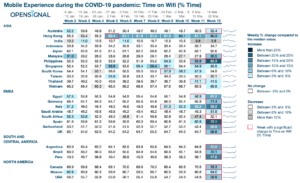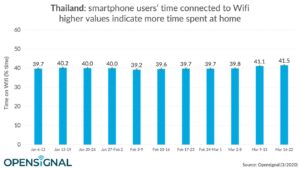- Given the interest in telecommunications created by the COVID-19 coronavirus pandemic and the restrictions on the movement of people that have been introduced to reduce its spread, Opensignal is providing details on the average amount on smartphone users’ time spent connected to Wifi across many regions and countries.
- Normally, the smartphone users’ Time on Wifi is higher at weekends and on public holidays than on weekdays, in other words when people are spending more time at home.
- Our analysis shows Time on Wifi for many of the largest economies within a region on a week-by-week basis and that Time on Wifi increased significantly on a week-on-week basis in the third week of March in many countries in Northern America and Europe, as well as in Australia, Argentina, Peru and Brazil. We will be updating this information during the crisis.
The amount of time that smartphone users spend on Wifi connections has increased in many countries
THAILAND, 08 April 2020 – The World is now facing a COVID-19 coronavirus pandemic, with an array of medical, social and economic challenges. Opensignal is analyzing the changes in mobile user behavior and network experience that are happening during this crisis. We plan to share our data and findings to help mobile operators, telecom regulators and governments to prepare for, and respond to, the challenges the virus presents in these exceptional times.
Many countries have now implemented restrictions on their citizens’ mobility to reduce the spread of the disease. We are in a fluid and fast-moving situation as people adapt their lives to a ‘new normal’ but one which has not yet stabilized. Countries are at different stages in their transition.
An early indicator of change is the average percentage of time smartphone users spend connected to Wifi (Time on Wifi). As people are spending more and more time at home, this is increasing. Normally, people spend more of their time connected to Wifi on weekends and during public holidays — demonstrating that it is a good indicator of increased time spent at home.
In some countries, the percentage of time people spend connected to Wifi can rise even before governments imposed official quarantine measures, as we saw in many Italian northern provinces during the early stages of the coronavirus outbreak. But now, restrictions are being implemented by more and more countries and we are observing Time on Wifi rise.

ASIA
Early on, we saw the percentage of time spent connected to Wifi rise in Hong Kong, but it was weeks before we saw significant changes in most of the other parts of Asia. We observed a large week-on-week jump in Time on Wifi in the Philippines in the third week of March, which began on March 16, with the country’s main island placed under quarantine. We also detected a smaller but still significant week-on-week increase in Time on Wifi in the Philippines in the second week of March. Other countries also experienced significant increases in the third week of March, including Malaysia and Australia. We have also seen the first signs that Time on Wifi is rising in Thailand as well. However, Time on Wifi declined in South Korea, likely reflecting reduced consumers’ concern at least for now.

Thailand specific bullets – Time on Wifi
- Opensignal first detected a statistically significant week-on-week increase in the percentage of time Thai smartphone users are spending on Wifi in the second week of March (starting March 9).
- Time on Wifi in Thailand. rose by 3.1% week-on-week to 41.1% in the second week of March, up from the 39.8% seen in the previous week. It then rose again in the third week of March (starting March 16) to 41.5%.
EUROPE
Many countries in Europe saw large increases in the percentage of time smartphone users spent connected to Wifi in the third week of March. Users in Spain recorded by far the largest week-on-week increase. This was the first full week of lockdown for the country and one in which it was declared the second worst-hit country in Europe. Italy saw this change take place much earlier, with the increase beginning in the last week of February.
NORTH AMERICA
In North America, we detected significant increases in the percentage of time smartphone users spent connected to Wifi in the third week of March, starting on March 16, with the largest change taking place in Canada. On March 15, the U.S. Centers for Disease Control and Prevention (C.D.C.) advised that no gatherings of 50 or more people over the next eight weeks should take place. The third week of March also began with the closure of New York’s bars, theatres and cinemas.
SOUTH AND CENTRAL AMERICA
South America is also showing increases in the percentage of time smartphone users spent connected to Wifi. Users in Argentina, Brazil and Peru spent considerably more Time on Wifi in the third week of March, starting on March 16, with Peru seeing by far the largest week-on-week change in percentage terms. This was the week that a 15-day quarantine came into effect in the country along with a mandatory 8pm-5am curfew. In contrast, Brazil’s most badly affected state to date – São Paulo did not enter lockdown until March 24.
About Opensignal
Opensignal is a mobile analytics company. It’s the independent global standard for understanding the true state of the world’s mobile networks based on measurements of real user experience. Opensignal’s industry reports are the definitive guide to the true experience consumers receive on wireless networks, and it independently measure this across every major network operator around the globe.
